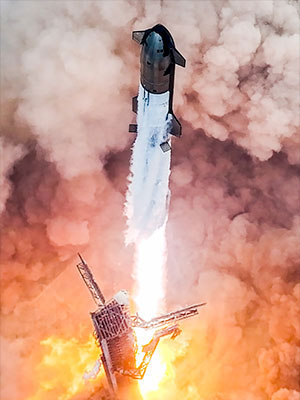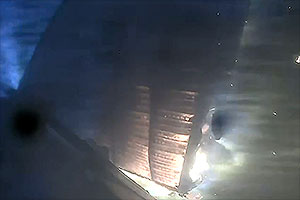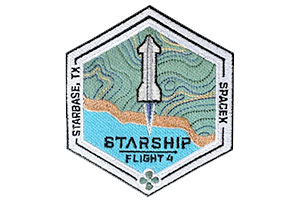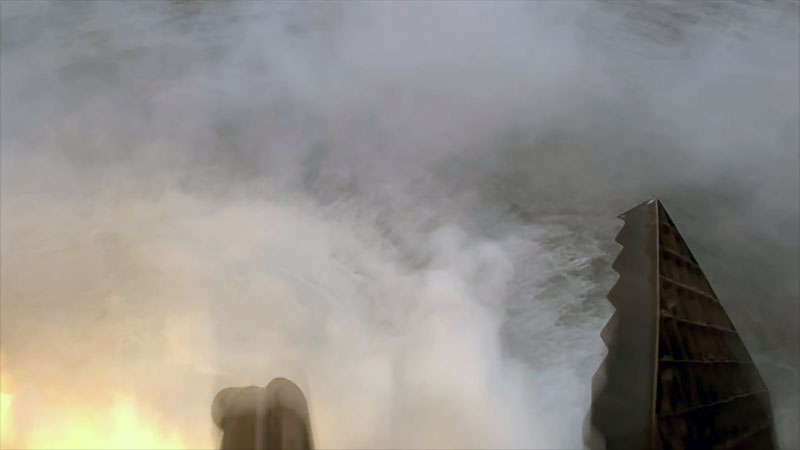 advertisements advertisements
|

|
SpaceX Starship successfully returns from space on fourth test flight
June 6, 2024 — Proving what goes up can come down, SpaceX accoplished its first fully-complete test flight of its Starship on Thursday (June 6), returning both the booster and spacecraft to splashdowns.
The successful hour-long suborbital flight came on SpaceX's fourth attempt to launch Starship, reach space and return to Earth intact. The prior test in March accomplished the ascent but did not survive reentry.
"From South Texas to the other side of the Earth, Starship is in the water. What a day.," said Dan Huot, SpaceX's communications manager, who helped provide commentary on the company's live webcast of the launch.
Thursday's flight began at 7:50 a.m. CDT (1250 GMT) with the liftoff of the nearly 400-foot-tall (121-meter) Starship from SpaceX's Starbase launch facility in Boca Chica, Texas. The vehicle's Super Heavy booster lit all but one of its 33 Raptor engines, beginning its climb skyward.
About two minutes and 45 seconds into the flight, the Super Heavy cut off most of its engines, the Starship spacecraft riding atop the booster ignited its engines and then two vehicles separated in a hot stage maneuver.
The Super Heavy then relit 13 of its engines to perform a "boostback burn," propelling it back towards Texas' coast, setting up its splashdown in the Gulf of Mexico. The booster next jettisoned its hot stage, the segment of the rocket that spanned between it and Starship. Future versions of the Super Heavy will have a lighter, integrated structure, but for this flight the stage had to be separated to lower the weight of the returning booster.
Still falling back to Earth while using four hypersonic grid fins to guide its way down, the Super Heavy performed a landing burn, firing 12 of the 13 engines planned, slowing its vertical descent to make a soft touchdown in the water. A camera view from on board the booster showed it tipping over into the gulf as it completed its flight about seven minutes after its launch.
Meanwhile, Starship continued climbing for another minute before cutting off its engines and coasting for 40 minutes to demonstrate its orbital ability and set up its targeted return to the Indian Ocean.
At about 48 minutes into the flight, Starship began its reentry, using the friction generated by Earth's atmosphere to slow its velocity as it descended. Relaying its video signal through SpaceX's Starlink broadband satellite network, live camera views showed plasma being built up around the spacecraft.
For this flight, SpaceX purposely removed two of its heat shield tiles to measure the effects of reentry on the ship's steel body using sensors to record the data.
Despite some clear damage to its structure on its way down — one of the ship's steering flaps looked to be close to having being burned off — Starship made it through the reentry and fired its engines for a landing burn before splashing down off the northern tip of Australia.
"Despite loss of many tiles and a damaged flap, Starship made it all the way to a soft landing in the ocean!" exclaimed Elon Musk, SpaceX's founder and CEO, in a post on the X social media network. "Congratulations [to the] SpaceX team on an epic achievement!!"
SpaceX did not plan to recover either Starship or Super Heavy, letting them both sink to their respective sea floors. When the vehicle is operational, the company plans for both the booster and spacecraft to return to their launch pad, touching down where they previously lifted off to enable "rapid and reliable reusability" of the full system.
SpaceX is developing Starship to ultimately fly humans to Mars, but first will use the vehicle to complete the deployment of its Starlink constellation and serve as a human landing system for NASA's first Artemis missions to return astronauts to the moon's surface. |
|

A Starship and Super Heavy booster lifts off on a test flight from SpaceX's Starbase in Texas on Thursday, June 6, 2024, (SpaceX)

A dramatic view of one of the control flaps on Starship as plasma burns through the structure during reentry, June 6, 2024. (SpaceX)

SpaceX's mission patch for Starship's fourth test flight. (SpaceX) |

A grid fin (at right) on the SpaceX Super Heavy rocket is seen as the Starship booster tips over into the Gulf of Mexico, having completed a successful fourth test flight and its first splashdown on Thursday, June 6, 2024. (SpaceX) |
|

© collectSPACE. All rights reserved.
|
|

|

|
